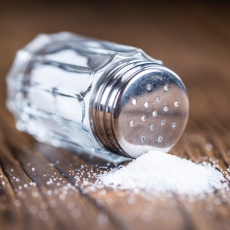

MEDICAL ENCYCLOPEDIA
National Institutes of Health
Other Languages
Table salt is a combination of two minerals - sodium and chloride Your body needs some sodium to work properly. It helps with the function of nerves and muscles. It also helps to keep the right balance of fluids in your body. Your kidneys control how much sodium is in your body. If you have too much and your kidneys can't get rid it, sodium builds up in your blood. This can lead to high blood pressure. High blood pressure can lead to other health problems.
Most people in the U.S. get more sodium in their diets than they need. A key to healthy eating is choosing foods low in sodium. The Dietary Guidelines recommend that most adults eat less than 2.3 grams per day. That equals about 1 teaspoon of table salt a day. Some people are more sensitive to the effects of salt than others and should eat less. This includes people who have high blood pressure, diabetes, or kidney problems, or are African-American or over age 50. Reading food labels can help you see how much sodium is in prepared foods.
NIH: National Heart, Lung, and Blood Institute
- Sodium Blood Test
 (National Library of Medicine)Also in Spanish
(National Library of Medicine)Also in Spanish
- Can Processed Foods Be Part of a Healthy Diet? (American Heart Association)
- Central Pontine Myelinolysis
 (National Institute of Neurological Disorders and Stroke)
(National Institute of Neurological Disorders and Stroke) - Salty Six
 (American Heart Association)
(American Heart Association) - Salty Stuff: Salt, Blood Pressure, and Your Health (National Institutes of Health)Also in Spanish
- Sea Salt vs. Table Salt: What's the Difference? (Mayo Foundation for Medical Education and Research)Also in Spanish
- Shifting the Balance of Sodium and Potassium in Your Diet (Harvard School of Public Health)
- Hyponatremia (Mayo Foundation for Medical Education and Research)Also in Spanish
- Test Your Sodium Smarts (American Heart Association)
- CDC Vital Signs: Where's the Sodium? (Centers for Disease Control and Prevention)
- ClinicalTrials.gov: Dietary Sodium
 (National Institutes of Health)
(National Institutes of Health) - ClinicalTrials.gov: Hyponatremia
 (National Institutes of Health)
(National Institutes of Health)
- Article: Sodium Reduction, Metabolomic Profiling, and Cardiovascular Disease Risk in Untreated Black...
- Article: Dietary Habits Bursting into the Complex Pathogenesis of Autoimmune Diseases: The...
- Article: The impact of mandatory iodine fortification and supplementation on pregnant and...
- Sodium -- see more articles
- CDC Vital Signs: Reducing Sodium in Children's Diets (Centers for Disease Control and Prevention)Also in Spanish
- Low Blood Sodium in Older Adults: A Concern? (Mayo Foundation for Medical Education and Research)Also in Spanish
- Cooking without salt (Medical Encyclopedia)Also in Spanish
- Low sodium level (Medical Encyclopedia)Also in Spanish
- Low-salt diet (Medical Encyclopedia)Also in Spanish
- Sodium blood test (Medical Encyclopedia)Also in Spanish
- Sodium in diet (Medical Encyclopedia)Also in Spanish





















.jpg)












No hay comentarios:
Publicar un comentario